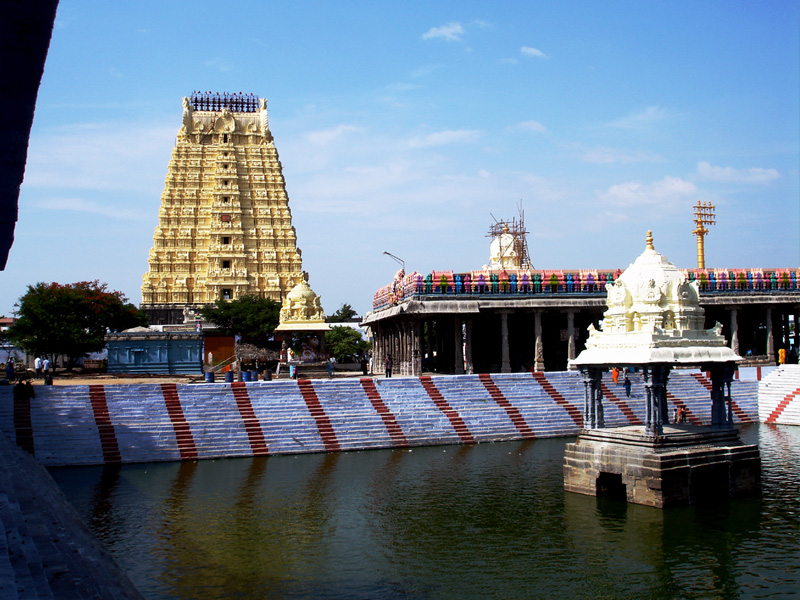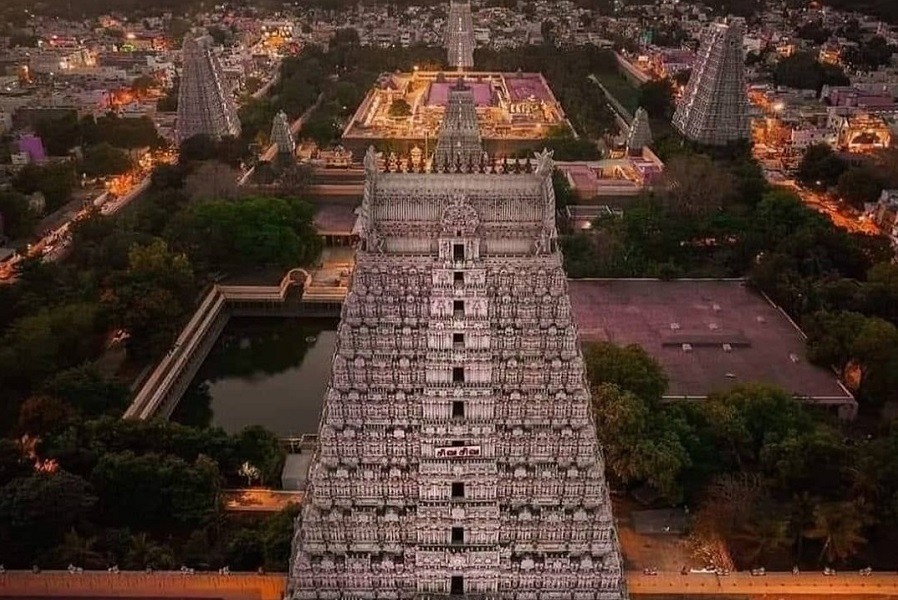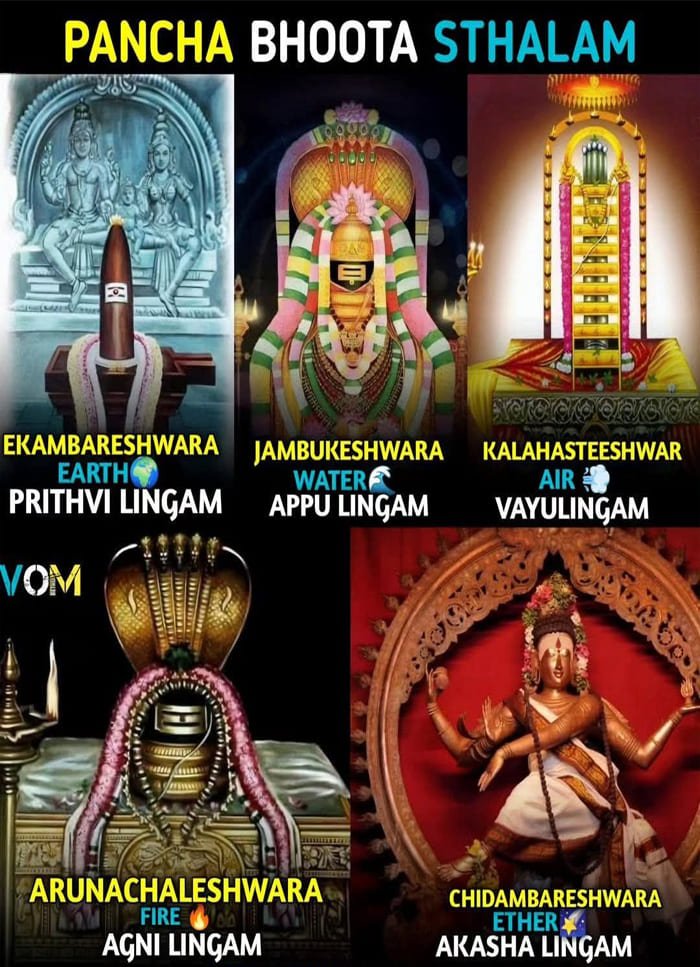Pancha Bootha Shiva Temples
The Vedas describe the physical universe as composed of five essential natural elements: earth, water, fire, air, and ether. Hence, five temples, known as the Pancha (Five) Bootha (nature elements) Sthalams, are dedicated to the five natural elements: earth, water, fire, air, and space making Lord Shiva the primary deity. The five elements are believed to be enshrined in the form of “Lingam” (abstract representation of Lord Shiva). These temples are situated in South India, mainly within Tamil Nadu and Andhra Pradesh.
1. EARTH – Ekambareswarar temple:

One of India’s oldest temples, dating back to at least 600 CE and mentioned in Tamil Sangam literature, Ekambareswarar Temple is where Shiva manifested as the Prithvi Lingam. It’s also the site of Goddess
Parvathi’s penance under a mango tree, where she faced Lord Shiva’s trials, leading to his appearance as Ekambareswarar.
Location: Kanchipuram, TamilNadu
Primary Deity: Ekambareswarar (Lord Shiva) and Elavarkuzhali (Goddess Parvathi)
Lingam: Prithvi Lingam
Significance:
- Architecturalheritage and intricate
- A 3,500-year-oldmango tree which is said to yield four different types of mangoes.
- Multipleshrines of various deities along with a pond.
- Weekly,monthly, and yearly rituals like Pradosham, Amavasai, Pournami, Chathurthi, Kalyanotsavam, etc.
- World-famous silk saree woven from Kanchipuram has designs of the temple.
Benefits of visiting:
- It provides a direct connection to the earth element, which is believed to ground and stabilize individuals.
- Alleviate problems related to the earth element, such as geological disturbances or health issues associated with imbalances
- Purifythe soul and cleanse negative
- Blessingsfor Stability and
- Spiritualgrowth with Enhanced Devotion and
- Historicaland Cultural
2. WATER – Jambukeshwarar temple:

This 7th-century South Indian Shiva temple, a masterpiece of Dravidian architecture, boasts towering gopurams (temple head towers), intricate carvings, and vast pillared halls. It features five courtyards and is famed for the legend of Goddess Akilandeswari’s water lingam penance under a Jambu tree. The lingam is notably damp, symbolizing the Cauvery’s flow, especially during monsoon season.
Location: Thiruvanaikaval, Trichy district, TamilNadu
Primary Deity: Jambukeshwarar (Lord Shiva) and Akilandeswari (Goddess Parvathi)
Lingam: Appu Lingam
Significance:
- A constant underground water spring flows around the Lingam in the temple’s inner sanctum
- Thesunken sanctum, with nine-holed stone windows, symbolizes human outlets, through which devotees worship the Lingam.
- JambuTree – Sthala Vriksham (Sacred Tree)
- Legendof Malyavan and Pushpadanta
- GoddessParvathi’s shrine contains 796
- Sculpted monolithic 1000 pillars, with chains and zodiac signs,mark one of the entrance of temple.
Benefits of visiting:
- Devotees receive blessings in this life and the next, with fulfilling wishes for intellect, learning, marriage, and offspring.
- It provides a direct connection to the water element, which is believed to purify and soothe.
- The perennial underground water stream is believed to cleanse the soul and purify negative energies
- Alleviate problems related to the water element, such as health issues associated with imbalances
- Blessings for Prosperity and Abundance
- Inner peace and cleanse negative
3. FIRE – Arunachaleshwarar temple:

Spanning approximately 10 hectares, this vast Indian temple is renowned for its four gopurams, with the 11-story eastern gopuram (temple tower) reaching 217 feet. Its extensive halls, including the famous thousand-pillared hall, and numerous shrines are also key features. This temple serves as a powerful source of spiritual energy and divine presence.
Location: Thiruvannamalai district, TamilNadu
Primary Deity: Arunachaleshwarar/Annamalaiyar (Lord Shiva) and Unnamalai (Goddess Parvathi)
Lingam: Agni Lingam Significance:
- KarthikaiDeepam Festival, a spiritually charged event
- Girivalam– circumambulations the hill
- RamanaMaharishi’s Ashram
- Associated with the Manipooraga (Manipura) chakra, linked to the solar plexus
- Considereda place of high spiritual energy Benefits of visiting:
- Providesa direct connection to the fire element, which is believed to purify and transform – Cleanse negative karma and facilitate spiritual growth
- Alleviate problems related to the fire element, suchas health issues associated with imbalances
- Anopportunity to connect with the teachings of Ramana Maharishi.
4. AIR – Kalahasteeswarar temple:

Srikalahasti, this Rahu-Ketu temple as well as known as the Dakshina Kailasam, has a 5th-century inner temple and an 11th- century outer temple. Lord Shiva, as Vayu (Air), is worshiped as Kalahasteeswarar.
Location: Srikalahasti, Tirupati district, Andhra Pradesh
Primary Deity: Srikalahasteeswara (Lord Shiva) and Gnana Prasunambika Devi (Goddess Parvathi)
Lingam: Vayu Lingam Significance:
- Calledas Dakshina Kailasam located on the banks of the river Swarnamukhi
- Associatedwith Rahu and Ketu imbalances
- Mahashivratricelebrations
- Legendbehind Gnana Prasunambika Devi, Kannappa, and Karpoora Lingam
- Theflickering flame in the Garbhagraha(Main sanctum)
- SadyogiMandapa and Jalkoti Mandapa hills
- SuryaPushkarani and Chandra Pushkarani water tanks Benefits of visiting:
- Provides a direct connection to the air element, which is believed to purify and
- Relief from Rahu-Ketu Dosha, planetary afflictions related to these shadow planets
- Alleviate problems related to the air element, such as respiratory issues or nervous system disorders.
5. SKY – Thillai Natarajan temple:

Chidambaram Natarajan Temple, a major Lord Shiva shrine, signifies ‘endless space’ (chit-ambaram). It symbolizes Lord Shiva-Vishnu unity, features a Sri-Chakra installed by AdiShankara, and primarily honours Natarajan, though Thirumoolanathar is the presiding deity.
Location: Chidambaram, Cuddalore district, TamilNadu
Primary Deity: Natarajan (Lord Shiva as cosmic dancer) and Shivakama Sundari (Goddess Parvathi)
Lingam: Akasha Lingam Significance:
- Primary temple dedicated to Natarajan, Lord Shiva in his cosmic dance form, symbolizing creation, preservation, destruction, concealment, and grace
- Veryimportant to cultural and dance practices in south India
- Symbolize the unity of Lords Shiva and Vishnu, fostering interfaith harmony
- The Chidambaram Rahasyam reveals Shiva as a formless, metaphysical presence, identical to the omnipresent and eternal Atman (Self).
- Festivals like Natyanajali, Arudra Darshan, Mahasivaratri attract cultural and arts people.
Benefits of visiting:
- Providesa direct connection to the space element, which is believed to expand consciousness and promote spiritual growth
- The cosmic dance of Natarajan is considered highly auspicious and is believedto bestow blessings for creativity, balance, and spiritual liberation
- Helpwith planetary afflictions
- Blessingsfor Arts and






Reviews
There are no reviews yet.